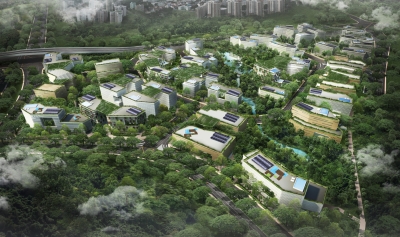Eco park lights up Singapore's green ambitions

SINGAPORE--A thriving hub that houses environmentally-conscious businesses. An epicenter for research, innovation and commercialization in clean technology. A green icon in housing and utilizing cutting-edge clean technologies. That is what Singapore's upcoming CleanTech Park (CTP) is striving to be under one roof.
Unveiled in February by the Economic Development Board (EDB) and local industrial developer and landlord JTC Corporation, CTP is set to boost the island-state's efforts toward building a greener, more energy-efficient and sustainable country. The development is said to contribute to Singapore's goal of becoming a "living laboratory", where clean tech companies can develop, testbed and commercialize green and urban solutions in the Republic before rolling out to the Asia-Pacific region and beyond.
Spanning 50 hectares (ha) in the western part of the island, CTP will be developed in three phases beginning this July. When fully complete in 2030, it is expected to house 20,000 people in about 30 buildings.

The first of these buildings, CleanTech One, will be built on a 1.5-ha plot. It will feature two towers covering a total of 37,500 square meters, and aim to be ready by December 2011. Construction costs alone for CleanTech One are estimated to be about S$90 million (US$65.5 million).
In an e-mail interview with ZDNet Asia, a JTC spokesperson shed more light on the ideas behind CTP, as well as some of the unique green features in the eco-business project.
Q: Where did the ideas for CTP come about? Which countries did EDB and JTC base its template on?
JTC: There are similar eco business parks around the world with different geographic locations presenting very different challenges. The team drew inspiration from Masdar City and the Sino-Singapore TianJin Eco-City when developing our ideas. The uniqueness of CTP lies in its objective of seeding and testbedding clean technologies in an urbanized and tropical setting. The development of CTP integrates and balances environment, economic and social objectives in a eco-sustainable approach.
What has been some of the learning so far? What ideas or plans were discarded, and why?
CTP is a testbedding platform where new technologies are being presented to us all the time. One idea that we had to do away with was basement carparks. Although a good solution to land optimization, underground carparks would result in diminishing the natural terrain and increasing the need for underground ventilation, thus increasing energy consumption.
Other ideas presented included technologies that appeared to be ideal in generating alternative energy. However, the cost of these technologies was prohibitive. Our aim is to build a park that is sustainable, yet cost-effective at the same time. We have to ensure that there are still affordable spaces for businesses to grow, and that being green makes good economic sense to the tenant.
Commercial buildings in Singapore have also taken the green path. The City Square Mall, for instance, has features such as waterless urinals and hybrid carpark lots with charging facilities. What are some interesting or novel green measures in CTP?
Innovative technological applications in CleanTech One would include a 1-megawatt fuel cell plant for renewable energy, a biodigester to move toward a zero food waste environment, and a dehumidification chiller to attain a more comfortable working indoor environment at a cheaper price.
At the bigger park level, recycled concrete will be used for roads and LED street lamps will also be testbedded to minimize light pollution and [reduce energy consumption by] 40 percent. Provisions to link buildings together with an integrated smart dashboard system will also be put in place so that energy and water usage can be compared on a district level, with feedback being provided to individual building owners and their tenants for improvement.
What green features should businesses and individuals remember or associate with CTP?
Two key important points underpin the design approach for CTP:
1. Conservation is important--existing greenery is kept as much as possible, bringing the tropical rainforest to the doorstep of businesses. We are doing away with the conventional method of cut-and-fill, [and instead] tailoring our infrastructure and building developments to the natural undulating terrain. Not only is biodiversity kept, cost of leveling the ground is also eliminated.
2. Ecologically sustainable yet affordable--CTP is looking at ways to build and operate in a cost-effective manner. While ecology and environmental sustainability are the park's distinguishing marks, commercial viability remains key. Predictive modeling is first used to minimize heat gain to the building, take advantage of natural prevailing winds in the park, and maximize solar and rain water collection at the roof. We hope that through our predictive modeling software, developers will find it easier and more cost-effective to build and operate a green building in CTP.
The planning principles for CTP's eco-sensitive masterplan are based on the following considerations:
- Protect and enhance the natural environment by minimizing cut and fill.
- Thorough considerations for green and blue elements--hydrology plan to cleanse, retain for evaporative cooling, as well as manage storm water onsite.
- Efficient building design--use of predictive modeling to optimize the building element design to better assist energy-efficiency measures.
- Cultivation of a green community--green practices will be promoted and encouraged through implementation of sustainable green programs. There will also be ongoing efforts to gather buy-in from the various industries and developers to take on a sustainable approach in the development of CTP through its phases.